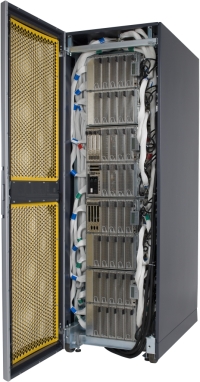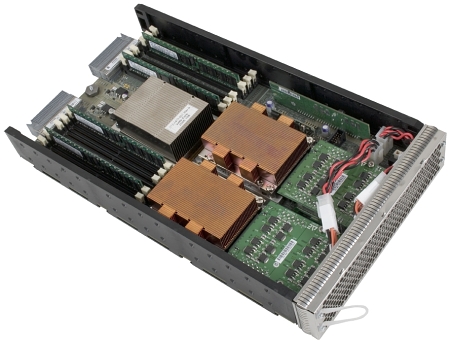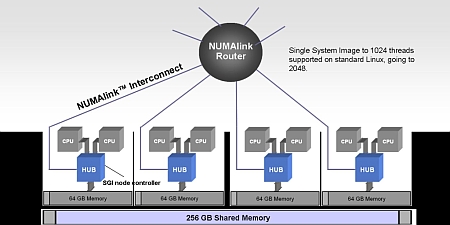World’s largest single-kernel Linux system?
Jul 26, 2007 — by LinuxDevices Staff — from the LinuxDevices Archive — 13 views NASA has selected an SGI Altix supercomputer to help it meet future high-performance computing requirements. The new system will be the first supercomputer to operate 2,048 processor cores and 4TB of memory under control of one Linux kernel, creating the world's largest single-kernel Linux system, NASA and SGI announced… this week.
NASA has selected an SGI Altix supercomputer to help it meet future high-performance computing requirements. The new system will be the first supercomputer to operate 2,048 processor cores and 4TB of memory under control of one Linux kernel, creating the world's largest single-kernel Linux system, NASA and SGI announced… this week.
 SGI Altix 4700 (Click to enlarge) |
Driven by 1,024 Dual-Core Intel Itanium 2 processors, the new system will generate 13.1 TFLOPs (Teraflops, or trillions of calculations per second) of compute power. Based hundreds of computer “blades” that each sport a pair of dual-core processors, the system provides an extremely high density of compute power per square foot, enabling NASA to pack more computing power into its supercomputing center. NASA also acquired an ultra-dense 240TB SGI InfiniteStorage 10000 system to efficiently handle the massive data storage requirements.
At 13.1 TFLOPS, the new Ames supercomputer would rank 64th on the latest list of the world's Top 500 supercomputers. The vast majority of high-performance supercomputers now run Linux, but most of them do this by running multiple instances of Linux over a cluster of computers.
NASA's new SGI Altix system is expected to be installed in August at the the NASA Advanced Supercomputing facility at the Ames Research Center at Moffett Field, Calif. The 2,048 processor-powered supercomputer operating under Linux can accelerate scientific research by making all of the system's processors and memory available to solve a single problem or several problems at once.
The Altix system uses a single instance of Linux, which runs in SMP (symmetric multiprocessing) mode up to 2,048 processors as though they were multiple cores on a single PC motherboard, according to Jill Matzke, Product Manager for SGI's Altix line. However, the latest production Linux kernel, version 2.6.22.1, supports a maximum of 1,024 simultaneous processors in SMP mode, she said.

Each blade computer contains two dual-core processors
Based on NASA's 2,048 processor requirement, SGI therefore is developing necessary modifications to support the 2,048 processors. The company has submitted these to the development community for inclusion in future kernel releases, Matzke said.
SGI's “NUMAlink interconnect” lets a single Linux kernel share up to 2,048 processors
“Supercomputers play a critical role in many NASA missions, including new space vehicle design, global climate studies and astrophysics research,” said Piyush Mehrotra, who leads the NASA applications group that is steering the technology upgrade effort. “We look forward to evaluating SGI's latest HPC offerings as part of our long-term technology refresh effort.”
The SGI Altix architecture accommodates the broad range of projects being pursued by NASA scientists, whose work demands both cluster and shared-memory computing architectures. NASA supports scientists and engineers throughout the U.S. who work on projects such as designing spacecraft, improving weather and hurricane models, and understanding the behavior of the sun. Many NASA projects require large, complex calculations and sophisticated mathematical models that can be efficiently handled only by a supercomputer, NASA said.
“NASA scientists already rely on SGI Altix systems for a range of research, from designing safer, more advanced spacecraft to understanding the long-term effects of climate change,” said Robert “Bo” Ewald, SGI's CEO, in a statement. “These researchers pursue work that is essential not only to the United States, but to the world at large. SGI looks forward to continuing to work with NASA as it seeks leading-edge HPC compute and data management solutions to meet its evolving needs.”
NOTE: Please post your comments regarding our articles using the above link. Be sure to use this article's title as the “Subject” in your posts. Before you create a new thread, please check to see if a discussion thread is already running on the article you plan to comment on. Thanks!
This article was originally published on LinuxDevices.com and has been donated to the open source community by QuinStreet Inc. Please visit LinuxToday.com for up-to-date news and articles about Linux and open source.
